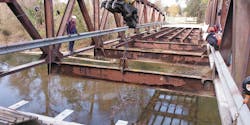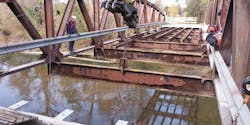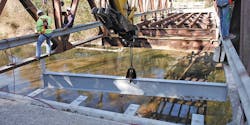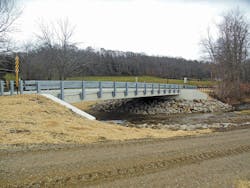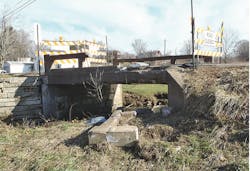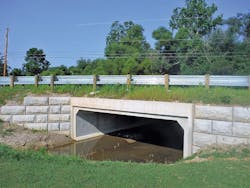Getting on program
As our nation’s infrastructure ages, emphasis is placed on the inspection and remediation of bridges. These bridges are travelled by school buses, family cars and pedestrians every day. How do engineers and county officials work together to ensure the safety of these travelers?
In Licking County, Ohio, a five-year bridge program was developed by the county engineer to manage, repair and replace aging county-owned structures. Gannett Fleming assisted the county engineer with identifying the deteriorated bridges and culverts, and assessing 158 bridges. Each bridge was evaluated and prioritized for repair or replacement. New bridges previously unrecorded in the county’s inventory also were discovered. The bridges were found to be in various conditions, from poor to critical, and some were even closed.
Using a ranking system to identify priorities for funding, general funds were successfully acquired and used to replace a large number of bridges and culverts over the five-year period. While bridges are driven over every day without a thought, this project reveals the focused, intentional process to repair and replace bridges to keep them in safe working condition.
Licking County Engineer’s Office developed an $18 million funding plan for bridge and culvert repairs.
Scope of asset challenges
In 2013 the Licking County Engineer’s Office staff embarked on a program to evaluate the conditions of its bridge and culvert assets, and asked Gannett Fleming for assistance. The staff anticipated that a small number of the county’s 432 bridges were in need of replacement or significant repair, but was not prepared for the full extent of the challenges in front of them. Gannett Fleming worked with the county staff to develop a system to not only confirm the National Bridge Inspection Standards (NBIS) condition ratings of the assets, but to also develop a 0-5-year coding system to prioritize maintenance and repair funds.
Gannett Fleming and Licking County developed a system for this five-year bridge program to categorize the bridge and culvert assets in a way that enabled the most critical structures to be identified and repair funds allocated as soon as possible. All of the bridge and culvert structures were rated a 4 (poor) or lower on the FHWA rating system.
The 70 worst
In 2013, Licking County planned out a bridge assessment of the county’s known 70 worst bridge and culvert structures. The assessment involved making site visits to all of the structures and evaluating them for categorization within the coding system of 0 to 5 years, wherein the zero-year bridges are in a more deteriorated condition than the five-year structures. The exact criteria to group the bridges was developed during this evaluation phase.
During the 2013 assessment, Gannett Fleming staff worked with Licking County staff regarding the identification and warning signs of critical problems. For example, a major water event may cause abutments or sheet piling to become undermined or significantly shifted, impacting overall structure stability. Undermined and shifted foundations can cause unstable structures and result in immediate load posting or closure.
Another example discussed during the first year was superstructure steel beams that have perforations (holes) in the webs, the shear zones, or that have significant section loss to flanges in the bending zones. These types of problems directly reduce the overall load capacity of the primary bridge structural members, which also can result in the bridge being posted or possibly closed.
In 2013 it became clear that the number of problem bridges was more than the county anticipated. In the course of the annual bridge inspections, the county staff identified more bridges to add to the list and reduced the condition ratings on those structures from a 5 or 6 down to a 4 based on the guidance above. Some bridges had not previously been classified and coded correctly, and there were others that had not been previously identified and listed in the bridge and culvert assets. The county staff called these “orphan bridges.” County staff also was concerned with the existing condition of a number of their larger steel structural plate arch-type culverts (40) and added a large portion of them to the total number in the program. At the end of the year the total number of assets in the program had increased from 70 to 158.
A total of 158 bridges and culvert assets were inspected and many were repaired or replaced.
The program grows
The full 158 bridge and culvert assets were inspected in 2014, which confirmed their rankings in the five-year bridge program. To complete an assessment of this magnitude, the county began with field inspections.
The field inspections involved making site visits to all of the structures and evaluating them for the coding system of 0 to 5 years. During the site visits, a number of bridges were either posted, had the number of lanes reduced to move vehicles away from deteriorated members, or were closed due to a significant number of deteriorated primary structural members. Several of the bridges that were closed were larger single-span steel truss bridges that spanned major county rivers.
As a result of these field inspections, a summary report was developed for each bridge. This enabled review and understanding of the critical problems on the respective bridge and culvert structures. The reports contained several photos, including a roadway level photo to properly locate the structure, and other condition photos that showed the specific structural problems of the subject bridge. The reports also contained the county bridge information, the coding number for the bridge or culvert (called a repair rating), and a brief summary of the critical problem(s).
To provide an overall picture of the situation, a color-coded bridge review table was developed to list the structures and their respective condition codes that signal recommendations for each bridge. The table also included the total number of bridges in each category:
- Four bridges with a Code 0—Red;
- 21 bridges with a Code 1—Orange;
- 23 bridges with a Code 2—Yellow;
- 34 bridges with a Code 3—Green;
- 30 bridges with a Code 4—Blue; and
- 46 bridges with a Code 5—Purple.
The review table enabled the county to focus on the 25 bridges coded 0 or 1 as the 2014 replacements began. Most of these bridges were successfully replaced in 2014.
With the county commissioners’ support, the Licking County Engineer’s Office has been able to replace an impressive number of bridges and culverts through the program. Since 2013, more than 80 bridges and culverts have been replaced. The average target has been around 20-30 bridges per year since 2013. This progress has been accomplished by a combination of local funding and federal and state grants.
Licking County Engineer Jared Knerr, P.E., P.S., is working to complete this bridge program, and replace and repair as many bridge and culvert structures as possible with the available funds. The infrastructure upgrade will continue through 2018.
The most critical structures were rated as a 4 (poor) or lower on the FHWA rating system.
Further challenges
In 2011, 331 bridges were on record in Licking County. After a detailed inspection of all county and township roads, the total number of bridges jumped to 432, meaning a total of 101 “orphan bridges” were added to the inventory.
The average number of bridges being replaced before 2011 was six per year. At that rate it would have taken over 70 years to replace every bridge. Bridges should have a life span between 50-70 years. Many of the bridges in the inventory are corrugated metal pipes (CMP), weathering steel truss bridges or steel beam bridges with no protective coating, which typically have a life span of up to 30 years.
Cost-effective replacement options were considered on most of the bridges, with the county opting to replace shorter-span structures with concrete culverts to reduce long-term maintenance costs. Another preferred structure type was single-span, prestressed concrete box beam bridges on integral abutments. The deteriorated larger truss bridges created another category of repair. With the county’s limited funding, targeted member replacement with galvanized new steel was preferred since a new bridge may typically cost $800,000 to more than $1 million. Several bridges were repaired at the end bays with new stringers and floorbeams, while other bridges were given full superstructure stringer and deck replacements. The county staff performed the construction.
Beyond the physical issues with the bridges, years of limited funding to county assets and the then-recent economic downturn reduced available funds and contributed to the scope of the problem.
Former Licking County Engineer Bill Lozier, P.E., P.S., started the five-year bridge program in 2013. His initial approach was to document, fund and execute the plan to solve the problem.
Licking County derives its road and bridge funds from gasoline taxes, collected by the state of Ohio and divided equally among Ohio’s 88 counties. Another significant source of funding is licensing fees paid during the annual vehicle registration renewal. During the economic downturn, the total funding to Licking County fell short by nearly $500,000 when the public reduced its annual spending as well as gas consumption.
After county commissioners were informed of the scope of the problem, they agreed to increase the county licensing fee by $5 and raise the county conveyance fee by $1 on every $1,000 of real estate sold. Combined, these measures generated over $800,000 annually for the program.
In total, the Licking County Engineer’s Office developed an $18 million funding plan for the repairs and replacements:
- 2014 estimate: $1.8 million;
- 2015 estimate: $3.7 million;
- 2016 estimate: $4.3 million;
- 2017 estimate: $4.5 million; and
- 2018 estimate: $4.5 million.
Since 2013, more than 80 bridges and culverts in Licking County have been replaced.
What other counties can learn
This systematic, detailed approach and methodology to structure asset management can be applied to counties across the country experiencing similar challenges. Aging infrastructure and limited funding is a common concern in many municipalities.
The residents of any county rely on their officials to maintain the infrastructure. Citizens often do not think of bridges or culverts until they are closed or in disrepair. By undertaking a thorough review of the county’s assets, prioritizing the needs and lobbying for the necessary funds, county officials in Licking County have reaffirmed their commitment to ensuring the safety of their residents, and will continue this program through 2018.
